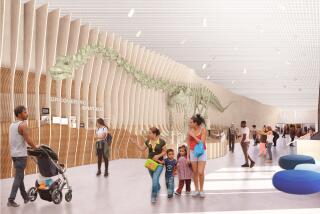I guess you could say paleontology was...
- Share via
I guess you could say paleontology was something I came across in my undergraduate studies at SDSU. While searching for something I was interested in doing, I took classes where I studied the Earth and ecosystems. This led me to paleontology, which is a bridge between geology and biology.
I have colleagues who grew up collecting shells and loving dinosaurs. As a kid, I spent a lot of time looking at natural settings. I was amazed by the changes in seasons and how flood waters can carry off sediment, rocks, houses, and so on. In my teens and early 20s, I did a lot of surfing, and that introduced me to the ocean and the dynamic nature of beach.
Probably the most dramatic setting is out in the desert; to be about 1,500 feet above sea level and look at remains that were deposited 7 million years ago of ancient sea creatures--like clams, snails, sea urchins, whales and sharks--and see how really dramatic the changes that have gone on are. I’ve been a paleontologist for 16 years and with the museum for 11 years. Prior to coming to the museum, I didn’t participate in excavations, but since coming, we have done lots of excavations, all local and in Baja California.
Everyone’s vision of a paleontologist is that we’re digging up dinosaurs. I’ve participated in plenty of excavations and found only one dinosaur, but it was exciting because it was a new kind of dinosaur for this area. About seven years ago we excavated a bone bed, which is a geologic layer that has a lot of bone in it, about a foot thick, in the Mission Hills area. We worked on that for about a month and a half, and we found a whole slew of bones of marine mammals.
What I enjoy most is the sense of discovery and digging into the past. I think every paleontologist has his own “wish list” of organisms he’d like to find. We have found bits and pieces of organisms that we’d like to find more of. Finding more would enable us to learn more, to unravel the evolution of this animal. The top of our wish list is the giant sea cow, which was probably 10 meters long. Over the years, we’ve found parts of this animal. It’s always very exciting to uncover the remains of an organism no one has seen before and the fact that you can read about the past from the rocks.
And the fossils, whether you are looking at ancient communities of herbivores or carnivores, bring to life how dynamic life is and how interesting and different and similar the processes are.
Competition, life, death, have all been a part of life for hundreds of millions of years. The only change has been the players. You’re able to look into the past and see how it relates to the future.
Through paleontology you are able to time travel. One of the things I’ve tried to do at the museum is bring that sense of amazement to time travel to the general public through classes and, until recently, exhibits.
The excitement of the kids who come to the museum is great. The youngest I remember had been a 3-year-old. He was so nuts on dinosaurs, he would just bowl you over on what he knew. He knew all the names and the stories the scientists have told about these animals. So to see his amazement at an actual dinosaur bone in the museum, when he actually got to hold the evidence of these stories, well, that’s exciting. It’s amazing how bright these kids are and how turned on they are to science.
I really enjoy the people I meet and work with. It takes a certain personality to like to do tedious things, like crawling around on your hands and knees looking for remains of organisms.






